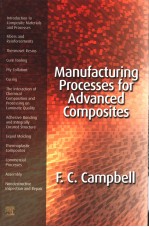

MANUFACTURING PROCESSES FOR ADVANCED COMPOSITESPDF电子书下载
- 电子书积分:16 积分如何计算积分?
- 作 者:F.C.CAMPBELL
- 出 版 社:ELSEVIER
- 出版年份:2222
- ISBN:1856174158
- 页数:517 页
Chapter 1 Introduction to Composite Materials and Processes 3
1.1 Laminates 3
1.2 Fibers 5
1.3 Matrices 9
1.4 Product Forms 12
1.5 Overview of Fabrication Processes 17
1.6 Advantages and Disadvantages of Composites 25
1.7 Applications 32
1.8 Summary 35
1.9 Acknowledgement 35
1.10 References 37
Chapter 2 Fibers and Reinforcements 40
2.1 Fiber Terminology 40
2.2 Glass Fibers 41
2.3 Aramid Fibers 44
2.4 Ultra-High Molecular Weight Polyethylene(UHMWPE) Fibers 45
2.5 Carbon and Graphite Fibers 46
2.6 Woven Fabrics 49
2.7 Reinforced Mats 54
2.8 Chopped Fibers 55
2.9 Prepreg Manufacturing 56
2.10 Summary 61
2.11 References 62
Chapter 3 Thermoset Resins 65
3.1 Thermosets 65
3.2 Polyester Resins 66
3.3 Epoxy Resins 67
3.4 Bismaleimide Resins 76
3.5 Cyanate Ester Resins 78
3.6 Polyimide Resins 79
3.7 Phenolic Resins 82
3.8 Toughening Approaches 83
3.9 Physiochemical Characterization and Quality Control 91
3.10 Chemical Testing 91
3.11 Rheological Testing 93
3.12 Thermal Analysis 95
3.13 Glass Transition Temperature 96
3.14 Summary 99
3.15 References 100
Chapter 4 Cure Tooling 104
4.1 General Considerations 104
4.2 Thermal Management 110
4.3 Tool Fabrication 118
4.4 Summary 129
4.5 References 130
Chapter 5 Ply Collation 132
5.1 Prepreg Control 132
5.2 Tool Preparation 133
5.3 Manual Lay-Up 134
5.4 Ply Collation 138
5.5 Flat Ply Collation and Vacuum Forming 141
5.6 Automated Tape Laying 144
5.7 Filament Winding 148
5.8 Fiber Placement 158
5.9 Vacuum Bagging 163
5.10 Summary 171
5.11 References 173
Chapter 6 Curing 180
6.1 Cure of Epoxy Composites 180
6.2 Theory of Void Formation 184
6.3 Hydrostatic Resin Pressure Studies 190
6.4 Chemical Composition Variables 198
6.5 Net and Low Flow Resin Systems 199
6.6 Resin and Prepreg Variables 200
6.7 Lay-Up Variables 201
6.8 Debulking Operations 203
6.9 Caul Plates and Pressure Intensifiers 206
6.10 Condensation Curing Systems 207
6.11 Residual Curing Stresses 210
6.12 Exotherm 217
6.13 In-Process Cure Monitoring 218
6.14 Cure Modeling 219
6.15 Summary 219
6.16 References 220
Chapter 7 The Interaction of Chemical Composition and Processing on Laminate Quality 226
7.1 Prepreg Physical Properties 226
7.2 Chemical Properties 227
7.3 Thermal Properties 229
7.4 Rheological Properties 230
7.5 Laminate Evaluations 231
7.6 Summary 238
7.7 References 239
Chapter 8 Adhesive Bonding and Integrally Cocured Structures 242
8.1 Adhesive Bonding 242
8.2 Advantages of Adhesive Bonding 242
8.3 Disadvantages of Adhesive Bonding 244
8.4 Theory of Adhesion 244
8.5 Joint Design 245
8.6 Adhesive Testing 250
8.7 Surface Preparation 251
8.8 Epoxy Adhesives 258
8.9 Bonding Procedures 262
8.10 Sandwich Structures 267
8.11 Honeycomb Core 269
8.12 Honeycomb Processing 277
8.13 Balsa Wood 285
8.14 Foam Cores 285
8.15 Syntactic Core 288
8.16 Inspection 289
8.17 Integrally Cocured Structure 290
8.18 Summary 298
8.19 References 299
Chapter 9 Liquid Molding 306
9.1 Preform Technology 306
9.2 Fibers 307
9.3 Woven Fabrics 308
9.4 Three-Dimensional Woven Fabrics 309
9.5 Knitted Fabrics 311
9.6 Stitching 312
9.7 Braiding 314
9.8 P4A Process 320
9.9 Random Mat 322
9.10 Preform Advantages 323
9.11 Preform Disadvantages 325
9.12 Integral Structures Made by Textile Processes 325
9.13 Preform Lay-Up 327
9.14 Resin Injection 331
9.15 Curing 335
9.16 RTM Tooling 336
9.17 Resin Transfer Molding Defects 338
9.18 Resin Film Infusion 341
9.19 Vacuum Assisted Resin Transfer Molding 349
9.20 Summary 354
9.21 References 355
Chapter 10 Thermoplastic Composites 358
10.1 The Case for Thermoplastic Composites 358
10.2 Thermoplastic Composite Matrices 360
10.3 Product Forms 368
10.4 Consolidation 369
10.5 Thermoforming 379
10.6 Joining 390
10.7 Summary 395
10.8 References 396
Chapter 11 Commercial Processes 400
11.1 Lay-Up Processes 400
11.2 Compression Molding 412
11.3 Injection Molding 420
11.4 Structural Reaction Injection Molding 430
11.5 Pultrusion 432
11.6 Summary 437
11.7 References 437
Chapter 12 Assembly 440
12.1 Trimming and Machining Operations 440
12.2 General Assembly Considerations 445
12.3 Hole Drilling 448
12.4 Fastener Installation 457
12.5 Sealing 467
12.6 Painting 468
12.7 Summary 469
12.8 References 469
Chapter 13 Nondestructive Inspection and Repair 473
13.1 Nondestructive Inspection 473
13.2 Visual Inspection 473
13.3 Ultrasonic Inspection 474
13.4 Portable Equipment 483
13.5 Radiographic Inspection 483
13.6 Thermographic Inspection 490
13.7 Repair 492
13.8 Fill Repairs 492
13.9 Injection Repairs 493
13.10 Bolted Repairs 497
13.11 Bonded Repairs 501
13.12 Summary 511
13.13 References 511
Appendix A- Metric Conversions 513
